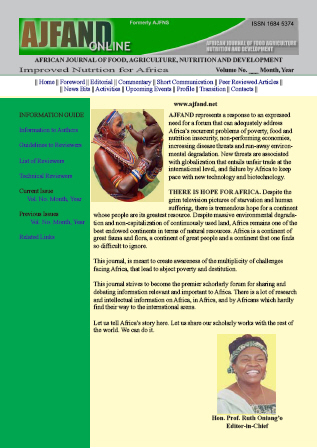
|
African Journal of Food, Agriculture, Nutrition and Development
Rural Outreach Program
ISSN: 1684-5358
EISSN: 1684-5358
Vol. 15, No. 4, 2015, pp. 10255-10271
|
 Bioline Code: nd15041
Bioline Code: nd15041
Full paper language: English
Document type: Research Article
Document available free of charge
|
|
|
African Journal of Food, Agriculture, Nutrition and Development, Vol. 15, No. 4, 2015, pp. 10255-10271
| en |
RESOURCE-USE EFFICIENCY AND OPTIMAL FARM PLAN IN PEPPER (Capsicum spp.) PRODUCTION IN OGUN STATE, NIGERIA
Ogunbo, Muinat M.
Abstract
This study estimated resource-use efficiency and optimal farm plan in pepper (Capsicum spp.) production in Ogun State, Nigeria during the pepper production/planting season in 2010. The data were collected from 120 pepper farmers who were sampled using a multistage sampling technique with the use of structured questionnaire and were analysed using descriptive statistics and linear programming (LP). The results revealed that 85% of the sampled farmers were male with a mean age of 43 years and mean pepper farming experience of 12 years. Majority (77%) of the respondents cultivated between 0.10ha and 1.54ha of land with a mean farm size of 1.23ha. This study also revealed that 35.0% of the farmers practised intercropping, 62.5% were into cultivation of sole pepper with a mean farm size of 0.93ha, and the enterprise combinations included pepper/maize (6.67%) with a mean farm size of 0.93ha, pepper/cassava (13.3%) with a mean farm size of 0.96ha, pepper/tomato (7.5%) with a mean farm size of 1.47ha, and pepper/maize/cassava (10.0%) with a mean farm size of 1.66ha. The major constraints in pepper production among the sampled farmers were inadequate viable and disease-resistant seeds (84.2%), inadequate transportation (90.8%) and inadequate access to finance/credit (90.8%). The results of the LP programme recommended pepper/tomato and pepper/maize/cassava enterprises and suggested a mean farm size of 0.25ha and 0.66ha for the two enterprises, respectively. The result further suggested that the mean farm size cultivated be reduced by 82.99% for pepper/tomato enterprise and 60.24% for pepper/maize/cassava enterprise. The optimum plan yielded an increase of 115.47% in gross margin of pepper/tomato enterprise and 31.62% of gross margin in pepper/maize/cassava enterprise. There is potential to improve output in order to harness the potential of pepper production to the optimum level. Therefore, enterprises such as pepper/tomato and pepper/maize/cassava which maximize the use of farm resources should be cultivated by the farmers in the study area. It is recommended that potential or practising pepper farmers should be enlightened on the basis of their capacity in terms of land area to cultivate and resources and/or inputs at hand.
Keywords
pepper; production; enterprises; combinations; linear programming; optimal; output; farmers
|
| |
© Copyright 2015 - African Journal of Food, Agriculture, Nutrition and Development
Alternative site location: http://www.ajfand.net/
|
|
